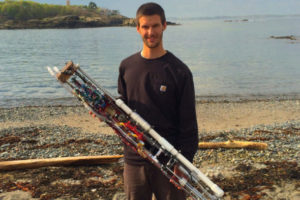This past weekend, a young Cuvier’s beaked whale washed up on the Philippine island of Mindanao with 88 pounds of plastic crammed into its stomach. The emaciated animal likely died of dehydration and starvation, unable to get any food past the mass of plastic bags, rice sacks, and tangled nylon ropes.

The animal likely died from dehydration and starvation, unable to get any food past the mass of plastic bags, rice sacks, and tangled nylon ropes. Photo courtesy of D’ Bone Collector Museum
Scientists have estimated that 8 million metric tons of plastic enter the ocean every year. While whales and sea turtles are perhaps the most visible victims of this pollution, they are far from alone. Plastics have worked their way into the entire ocean food chain, starting with microbes and filter feeders and ending up on our own dinner plates.
“Because it’s designed to last forever, when [plastic] accidentally gets into the ocean, it doesn’t go away,” said Northeastern researcher Ethan Edson, addressing a small crowd on the 9th floor of Renaissance Park as part of the Contemporary Issues in Security and Resilience Studies speaker series.
Edson, a research technician at the Field Robotics Laboratory at Northeastern’s Marine Science Center, has been working on an autonomous sensor to study microplastics, pieces of plastic in the ocean smaller than 5 millimeters. While they’re less noticeable than a drifting plastic bag, they can be just as hazardous. Plastics at this size are often eaten by small fish or filter feeders who mistake them for food.
“They’re eating empty calories,” Edson said. “They’re eating microplastics, and they’re becoming full, but they’re getting zero nutritional value.”
Additionally, these plastics can attract and concentrate chemicals in the water. Animals that ingest them may take in the extra toxins as well. And both the plastics and the toxins are passed on when predators eat these smaller fish.
“For us, who are at the end of the line eating these fish, it’s not great to find out they might have a higher level of toxins because they’re ingesting these microplastics,” Edson said.
And fish are not the only thing we eat that might contain microplastics.
“Microplastics have been found in drinking water, beer, sea salt, honey, the air that we breathe,” Edson said. “A recent medical study found evidence of microplastics in every stool sample.”
Despite the potential hazards, researchers have a limited knowledge about the distribution of

During his senior year at Northeastern, Ethan Edson designed an autonomous sensor to detect microplastics in the ocean. Photo courtesy of Ethan Edson
microplastics in the ocean. Collecting this data currently requires heading out to sea in a research vessel, dragging fine nets through the ocean, and sorting through the catch under a microscope. It is a time-consuming and expensive endeavor.
Edson’s sensor, called MantaRay, could be an inexpensive way to vastly expand the data scientists have on microplastics. The device is intended to collect data while attached to underwater vehicles, buoys, and even the hulls of ships.
MantaRay uses an optical sensor to identify the different types of plastics in the water and calculates how concentrated they are depending on how fast water is flowing through it. It can send that information back to researchers via satellite or cell networks, along with water temperature and salinity. Then it collects the microplastic particles for researchers to analyze later.
Edson designed the first version of MantaRay as his capstone project during his senior year at Northeastern. His design won the undergraduate award in the engineering and technology category of Northeastern’s Research and Innovation Expo.
Since then, he has continued to develop MantaRay and several other sensors with the help of Mark Patterson, a Northeastern professor and expert in marine robotics. Their challenge now is to find a way to build enough devices to collect the massive amounts of data researchers need.
“Only on this scale are we really going to understand what’s going on and how microplastics are interacting with our ecosystems,” Edson said. “We want to understand the biological significance and eventually the human health impact.”

